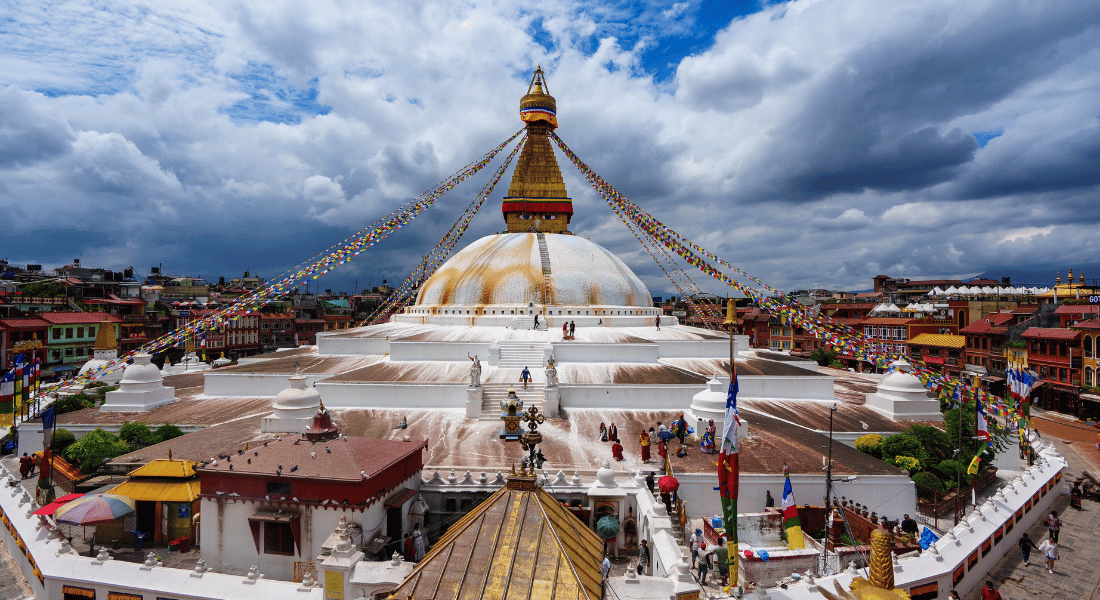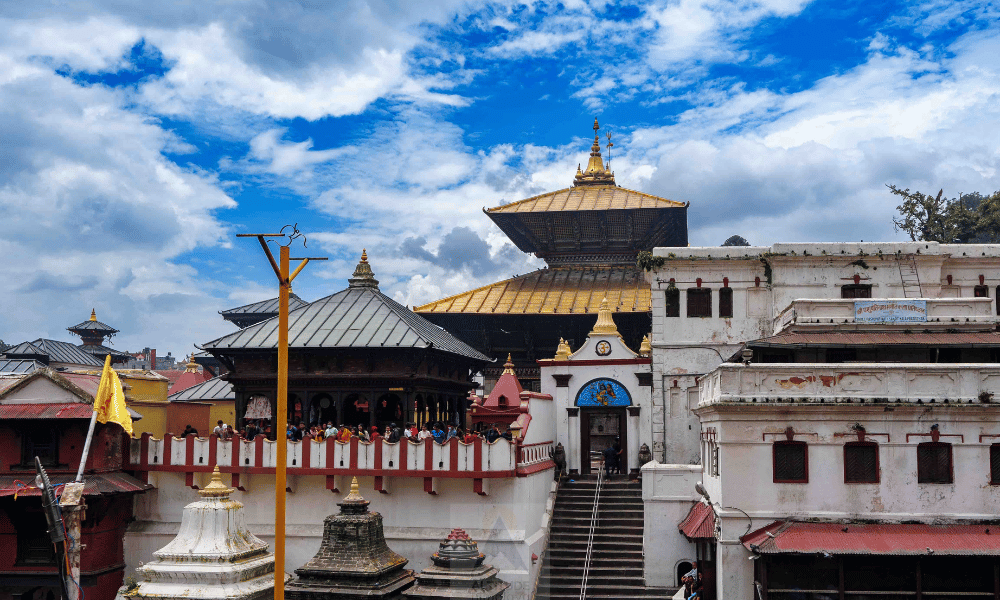Pagoda temples, with their magnificent and recognizable forms, serve as famous monuments throughout Asia. These magnificent structures, whether towering in multi-tiered majesty or flawlessly curving into the heavens, are more than just architectural wonders; they are living evidence to the rich fabric of culture, spirituality, and creativity that has weaved through the continent for centuries. As we proceed on a journey to learn about the deep meaning of pagoda temples, we are drawn into a world where faith, devotion, and enlightenment.
Pagoda temples can be traced back to ancient India, where they first became known as stupas in Buddhism. These holy structures were built to keep the relics of revered spiritual teachers and to represent the spiritual road to enlightenment. This architectural form evolved and spread over time, reaching regions as diverse as Japan, China, Myanmar, and Nepal, each integrating their own distinct cultural and artistic tastes into the concept of the pagoda. Pagoda temples, also known as shikharas and gopurams in Hinduism, present a spectacular blend of devotion and artistry, serving as residence for many deities and embodying the rich traditions of this ancient belief.
Pagoda temples serve more than just as physical structures; they serve as spiritual anchors, attracting pilgrims and followers from all over the world. These temples serve as a venue for rituals and cultural festivals, generating a deep sense of shared identity and faith. Pagodas' complex carvings, bright decorations, and multi-tiered roofs are artworks that tell the stories of the cultures who inhabit them. As we explore the world of pagoda temples, we embark on a trip that transcends time and boundaries, demonstrating humanity's unlimited creative spirit and deep devotion.
Historical Background
Pagoda temples have a fascinating history that goes back over thousands of years and is full of evolving cultures, changing architecture, and the close connection between art and religion. It all started in ancient India with the rise of stupas, which created the groundwork for the pagodas we know today.

The first pagodas, known as stupas, are closely associated with Buddhism and date back to the 3rd century BCE, during the period of the great Buddha, Siddhartha Gautam. These early stupas were basic hemispherical structures built to house sacred objects most often those of the Buddha or his renowned disciples. They represented key Buddhist teachings, particularly the Four Noble Truths and the Eightfold Path, which serve as the foundation of Buddhist philosophy. Originally, stupas were plain, solid hemispheres that symbolized spiritual simplicity.
The stupa evolved significantly as Buddhism spread throughout Asia. The stupa grew into the famous pagoda we know today in China, influenced by Daoist and Confucian traditions. Multiple layers and upturned, curved roofs, typical of Chinese pagodas, were added during this architectural change. These pagodas were not just places to store Buddhist relics, but also places of worship, meditation, and the conveying of spiritual teachings. They became symbols of architectural innovation and spiritual enlightenment, capturing the fundamental principles of Buddhism while incorporating traditional Chinese architectural characteristics.
The pagoda's influence grew beyond China into other East Asian countries. Pagodas in Japan, for example, were converted into magnificent buildings that exemplified Japanese workmanship. The pagoda concept took a different form in South Asia, with Hindu temple architecture adopting towering shikharas and gopurams with beautiful carvings and bright decorations, reflecting the combination of art, culture, and devotion. Pagoda temples are still built today utilizing ancient methods or modern materials, keeping the historical character of these beautiful structures that serve as places of worship and cultural significance throughout East and Southeast Asia. These regional changes demonstrated the pagoda's ability to evolve while keeping its spiritual and cultural value.
Pagoda temples’ history demonstrates the adaptability and dedication of religious and architectural ideas as they crossed geographical and cultural borders. It's a story about spiritual expression and artistic study, about the passage of time and the continuing legacy of human creativity and dedication throughout Asia.
Features of Pagoda Architecture
Pagoda architecture is characterized by several distinctive features that make it unique and instantly recognizable. These features vary based on regional styles and cultural influences, but the following elements are commonly associated with pagoda architecture:
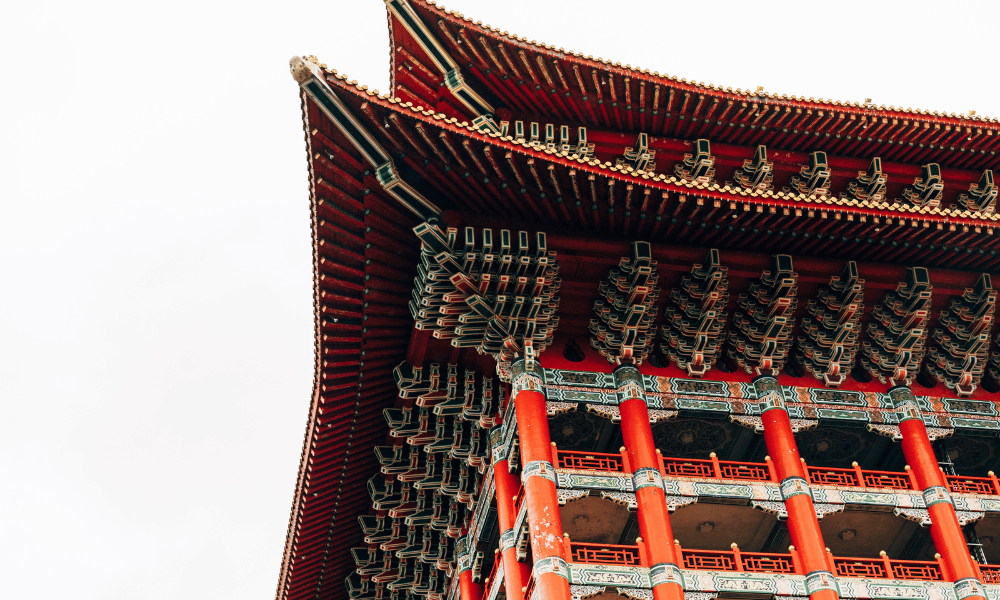
Tiered Structure: Pagodas are multi-tiered structures with multiple levels stacked on top of one another. These levels generally shrink in size as they go up, providing a narrowing effect that is both visually beautiful and meaningful.
Central Core: The structural backbone of the pagoda is a central pillar or core, which is commonly composed of wood, stone, or other strong materials. Sacred relics, scriptures, or idols are housed in this core.
Sloped Roofs: Pagodas are distinguished by their upturned, sloped roofs, which form a distinct and beautiful shape. In Chinese and Vietnamese pagodas, these curving components are more prominent.
Decorative Roofs: Pagoda roofs are typically covered with decorative elements such as wood carvings, paintings, and complex design. These decorative components generally represent religious or cultural concepts.
Stupas: A stupa is often built at the very top of a tower, especially in Buddhist architecture. Stupas are dome-shaped buildings that are often used to store relics or other sacred items.
Symmetry: Pagodas are made to be symmetrical, which means that their layout and decorations are similar on all sides. This symmetry makes them look even more appealing.
Intricate Carvings: Many pagodas feature detailed exterior carvings. These carvings frequently depict religious or mythological scenes and can be both visually appealing and symbolically rich.
Entrances: Pagodas typically have numerous entrances on different levels, allowing worshipers and visitors to enter. These entrances typically feature beautifully designed doorways and gateways.
Choice of Materials: Pagodas are constructed using various materials, including wood, stone, brick, and, in modern structures, concrete. The choice of materials can vary based on regional preferences and availability.
Cultural Variations: Different regions and cultures have their unique interpretations of pagoda architecture. Chinese pagodas, for instance, may have distinctively curved roofs, while Japanese pagodas feature straight, sloping roofs.
Spiritual Significance: Pagodas serve as places of worship and meditation and are often repositories of religious relics, sacred texts, and revered statues. They hold deep spiritual and cultural significance for the communities they serve.
Landscape Integration: Pagodas are often strategically situated in picturesque locations, such as hilltops, temple complexes, or near water features. Their surroundings are carefully chosen to enhance their visual impact and create a serene and contemplative atmosphere.
These architectural features collectively contribute to the timeless and captivating allure of pagoda structures, reflecting both their aesthetic beauty and their profound spiritual and cultural importance in the regions where they are found.
Materials and Construction Techniques
Materials and construction techniques of pagoda temples can vary depending on their regional styles, cultural influences, and historical periods. Here are some common materials and construction techniques used in the creation of pagoda temples:
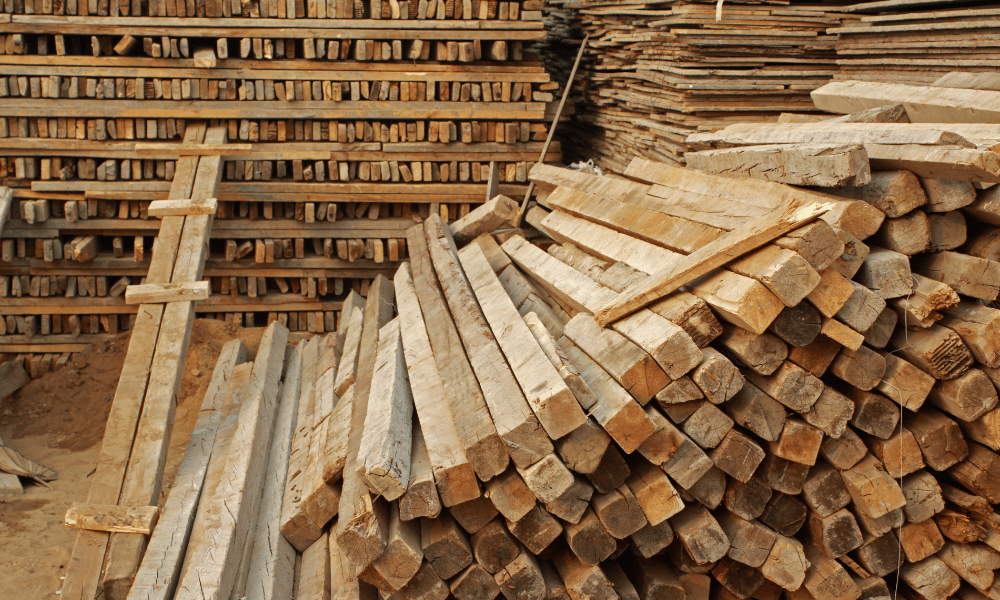
Materials:
Wood: Wooden pagoda temples are common in regions with ample timber resources, such as Japan and parts of China. Various types of wood, often cedar or cypress, are used for their construction.
Brick: Brick is a durable and widely used material for pagodas, especially in regions with a history of brick-making. Many Chinese pagodas, including the famous Giant Wild Goose Pagoda in Xi'an, are constructed using brick.
Stone: Some pagodas, particularly in South India, are constructed using stone. Granite, sandstone, and other types of stone are used to create intricately carved and durable structures.
Mud and Earth: In regions with limited resources, such as parts of Nepal and Tibet, pagodas are constructed from rammed earth or adobe bricks, which are economical and readily available materials.
Tile: Roof tiles play a crucial role in both the structural integrity and aesthetics of pagodas. Glazed tiles may be used for colorful and decorative roofing. The pattern and color of the tiles can vary according to regional styles.
Concrete: In modern construction, concrete is often used due to its durability and cost-effectiveness. Concrete pagodas can mimic the appearance of traditional wooden or brick pagodas while offering greater longevity.
Construction Techniques:
Post-and-Beam Construction: Wooden pagodas, particularly in Japan, often use post-and-beam construction. Massive wooden columns and beams provide the structural framework for the temple. The intricate joinery ensures stability.
Masonry Techniques: Brick and stone pagodas use various masonry techniques, including stacking bricks or stones with mortar. Intricate carvings, sculptures, and relief work are added during the construction process.
Stupa Construction: In the case of stupas in Buddhism, a solid core containing relics and other sacred items is constructed first, and then layers of bricks or stones are added to form the hemispherical shape. The entire stupa may be covered in a smooth, plaster-like finish.
Lacquer Work: Some pagodas, especially in Japan, employ lacquer techniques to protect and enhance the wood. Lacquered finishes can also include decorative patterns and colors.
Stupa Enshrinement: In Buddhist stupas, a consecration process is a significant part of construction, involving the placement of sacred relics or symbolic objects within the stupa's central core.
The materials and construction techniques used in pagoda temples are a reflection of the local culture, available resources, and the architectural traditions of the region. These structures represent not only places of worship and spirituality but also the artistry and craftsmanship of the communities that build and maintain them.
Regional Variations
Regional variations of pagoda temples exist due to the diverse cultural, architectural, and religious influences across East and Southeast Asia. Each region has its unique interpretation of pagoda temple architecture, resulting in distinct features and styles. Here are some notable regional variations:
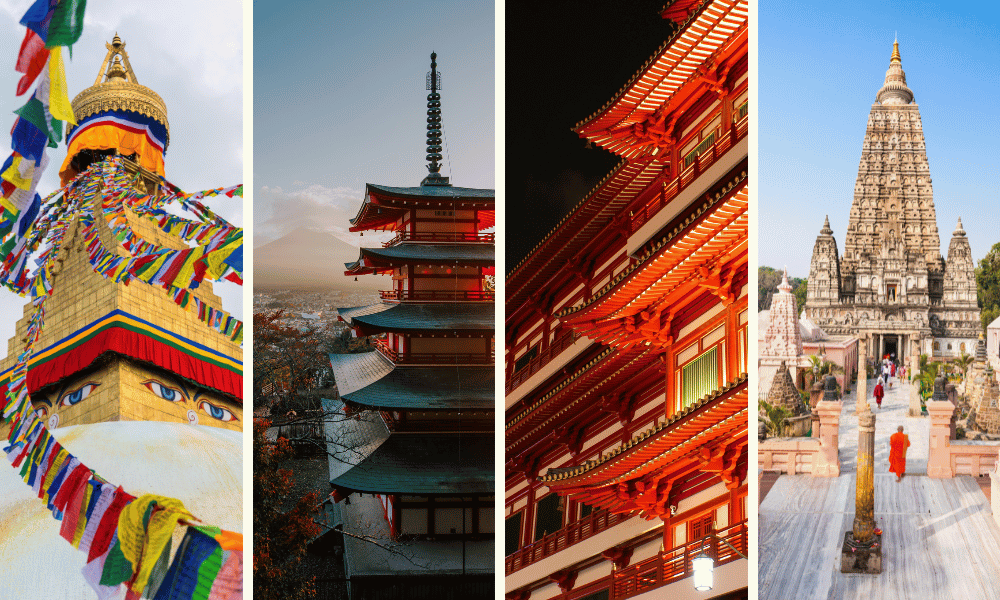
Nepalese Pagodas:
Newar Style: Nepalese pagodas, often referred to as "Newar pagodas," feature tiered structures with elaborate woodcarvings and intricate window designs. The pagodas are commonly found in Nepal's Kathmandu Valley.
Exquisite Woodwork: Nepalese pagodas are known for their exquisite woodwork, with elaborately carved windows, doors, and struts that depict both religious and mythological themes.
Multi-Roof Tiers: Nepalese pagodas often feature multiple roof tiers, with each tier exhibiting elaborate carvings and ornate details. The number of tiers may vary.
Gajur: Nepalese pagodas are known for the decorative "gajur" (a pinnacle-like element) at the top, which is beautifully adorned and plays a significant role in the aesthetics of the structure.
Chinese Pagodas:
Distinct Curved Roofs: Chinese pagodas are known for their gracefully curved roofs that sweep upwards at the corners, often with ornate tile work.
Intricate Carvings: Chinese pagodas often feature intricate carvings, such as dragons, phoenixes, and traditional motifs, both on the exterior and interior.
Numerology: Chinese pagodas often incorporate numerological symbolism. For example, you may find pagodas with an odd number of tiers, which is considered lucky in Chinese culture.
Indian Pagodas:
Influence of Hindu Temples: Indian pagodas are influenced by Hindu temple architecture, characterized by the shikhara (spire) at the top, intricate sculptures, and vibrant colors. These structures are often seen in northern India.
Ashoka Pillars: Some Indian pagoda temples incorporate Ashoka pillars, which are tall, finely carved stone pillars. These pillars often carry edicts and inscriptions related to Emperor Ashoka and Buddhism.
Intricate Carvings: While Indian stupas tend to be simpler in design compared to East Asian pagodas, they may still feature intricate carvings and bas-reliefs that depict scenes from the life of Buddha and other Buddhist narratives.
Japanese Pagodas:
Straight, Sloping Roofs: Japanese pagodas typically have straight, sloping roofs with a more angular appearance compared to the curved roofs of Chinese pagodas.
Minimalistic Design: Japanese pagodas often exhibit a more minimalistic design aesthetic with simple, unadorned surfaces.
Korean Pagodas:
Square Tiers: Korean pagodas are distinctive for their square tiers and sharp corners, in contrast to the rounded or curved tiers seen in some other regions.
Twin Pagodas: Some Korean temples feature paired pagodas, symbolizing harmony and balance, a unique feature in Korean temple architecture.
Burmese (Myanmar) Pagodas:
Golden Splendor: Myanmar is renowned for its magnificent golden pagodas, with the Shwedagon Pagoda being one of the most famous examples. These pagodas are covered in gold leaf, creating a resplendent and shimmering effect.
Bell-Shaped Domes: Many Burmese pagodas feature bell-shaped stupas at the top, crowned with a Hti, a decorative umbrella-like finial.
Thai Pagodas:
Spire-like Form: Thai pagodas often have a tall, spire-like appearance with multiple tiers that taper to a pointed top. The pinnacle may be adorned with colorful mosaic tiles.
Ornate Decorations: Thai pagodas are richly decorated with intricate patterns, Thai art, and religious motifs, known for their vibrant and ornate appearance.
These regional variations in pagoda temple architecture highlight the cultural diversity and artistic traditions across East and Southeast Asia. Each region's pagodas reflect their unique history, beliefs, and architectural styles, contributing to the global appreciation of these iconic structures.
Cultural and Religious Significance
East and Southeast Asian pagoda temples are architectural marvels that resonate profoundly within the region's cultural and religious fabric. They are timeless symbols of the spiritual and artistic heritage of the regions they honor.
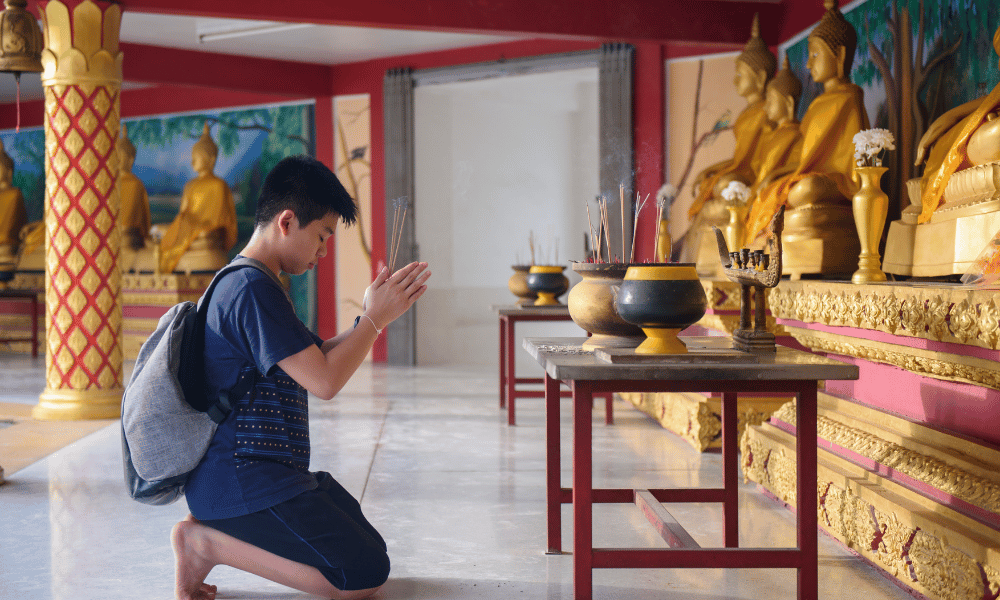
Pagoda temples are honored culturally for their historical and architectural significance. They represent the collective knowledge and skill of the previous generations and provide a tangible connection to a rich cultural legacy. The complex carvings, elaborate decorations, and colorful paintings that decorate pagodas are not simple ornaments; they are an archive of carefully preserved stories, beliefs, and artistic expressions. The design of each pagoda reflects the aesthetics and values of its community, with its devotion to harmony and symbolism reflecting lasting cultural principles.
Pagoda temples have an immeasurable religious significance. These sacred structures are spiritual retreats where devotees gather for worship, meditation, and reflection. In the context of Buddhism, which has a strong association with pagodas, these temples usually house relics of the Buddha or revered monks, making them focal points of worship. Pagodas are regarded as gateways to the divine, places where one can find comfort, enlightenment, and inner peace. Pagoda temples, regardless of the religious tradition to which they belong, develop a sense of unity and collective devotion. They provide spiritual nourishment and shelter to those who desire a connection with the divine.
In the Hindu religion, pagoda-style temples frequently house idols of gods and goddesses and feature multi-tiered structures decorated with intricate carvings, and sacred symbolism, thereby evoking a reverent atmosphere. Within these sacred spaces, devotees desire a direct connection with the divine, which fosters a sense of spiritual solace, enlightenment, and inner peace. These temples represent the interconnectedness of humanity and the divine in the rich tapestry of Hinduism, providing an escape for those on a spiritual journey who seek to establish a deeper connection with the divine. Regardless of their beliefs, the pagoda temples influenced by Hinduism embody the spirit of unity, community, and the pursuit of profound devotion and spiritual development.
Pagoda temples, with their stacked layers reaching for the heavens, bridge the gap between the physical and the spiritual. They represent the interplay between culture and spirituality, making them not only architectural marvels but also living testaments to Asia's distinguished heritage. Their enduring appeal comes from their capacity to inspire wonder, create self-reflection and serve as cultural and religious symbols. In this sense, pagoda temples remain crucial and treasured aspects of the communities they serve.
Notable Pagodas
Here are notable pagoda temples from various regions:
Pashupatinath Temple - Kathmandu, Nepal
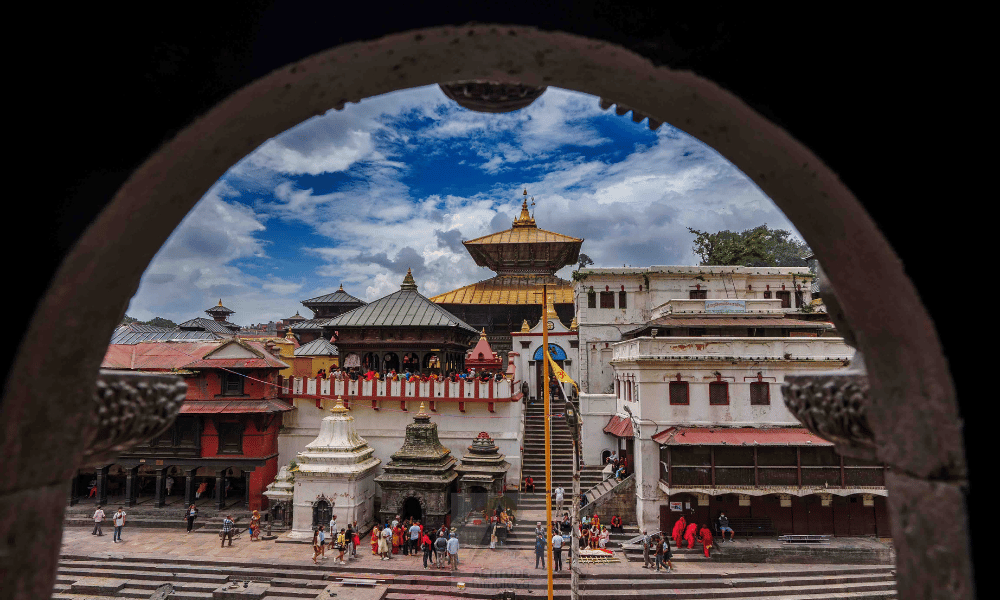
The Pashupatinath Temple in Kathmandu, Nepal, is a famous and holy Hindu temple that is known for its unique style of architecture. The temple is built in the traditional Nepalese pagoda style, which is known for its multi-tiered roofs and intricate wood carvings. The main structure of the temple is a beautiful pagoda with four silver-plated doors that each depict a different scene from Hindu legends.
Lord Shiva is worshiped at the Pashupatinath Temple, which is an important travel site for Hindus all over the world. It is a unique cultural and spiritual treasure because of the way it was built, which is full of holy symbols and fine Nepalese craftsmanship. The temple complex is on the banks of the Bagmati River and is both a place of prayer and a UNESCO World Heritage Site. It shows how deeply architecture and religion are connected in Nepal.
Learn More: Pashupatinath Temple
Swayambhunath Stupa (Monkey Temple) - Kathmandu
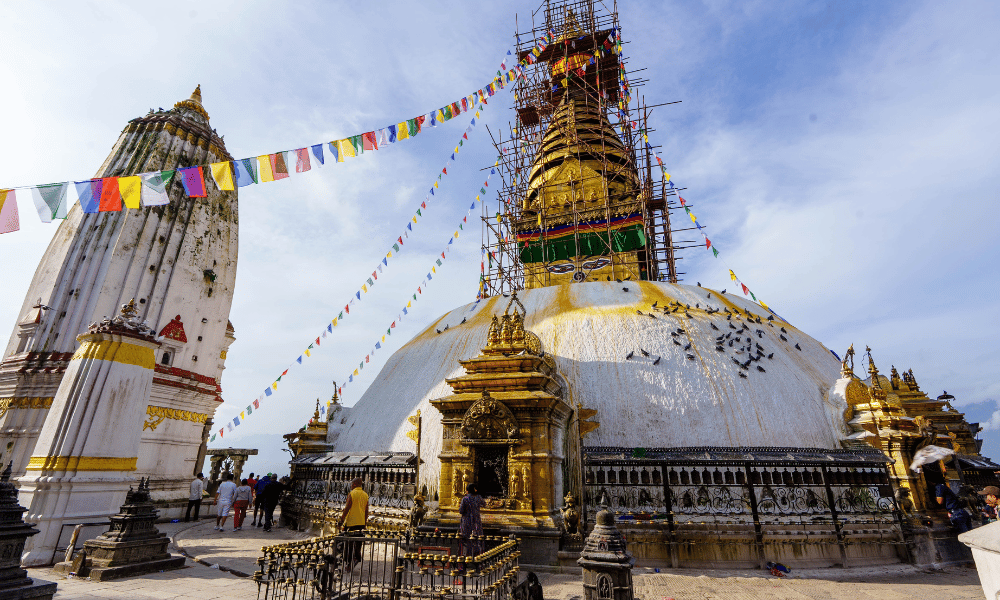
The Swayambhunath Stupa, which people affectionately call the "Monkey Temple," is an important religious and historical site in Kathmandu, Nepal. This famous stupa is an example of the traditional way of building Nepalese pagodas. It stands out because it has a whitewashed roof with a golden spire on top of it. A beautiful square base surrounds the stupa, and Buddha's eyes are drawn on each side of the base, looking peacefully in the four directions.
The style of architecture at Swayambhunath shows how Nepalese Buddhism has a long and rich history. This holy place is decorated with prayer wheels, prayer flags, and intricately carved stones. It is both an architectural masterpiece and a spiritual retreat that has drawn pilgrims and tourists from all over the world for hundreds of years. The Swayambhunath Stupa is not only a beautiful piece of architecture, but also a reminder of Nepal's deep spiritual roots and artistic talent.
Learn More: Swayambhunath Stupa
Sanchi Stupa - India
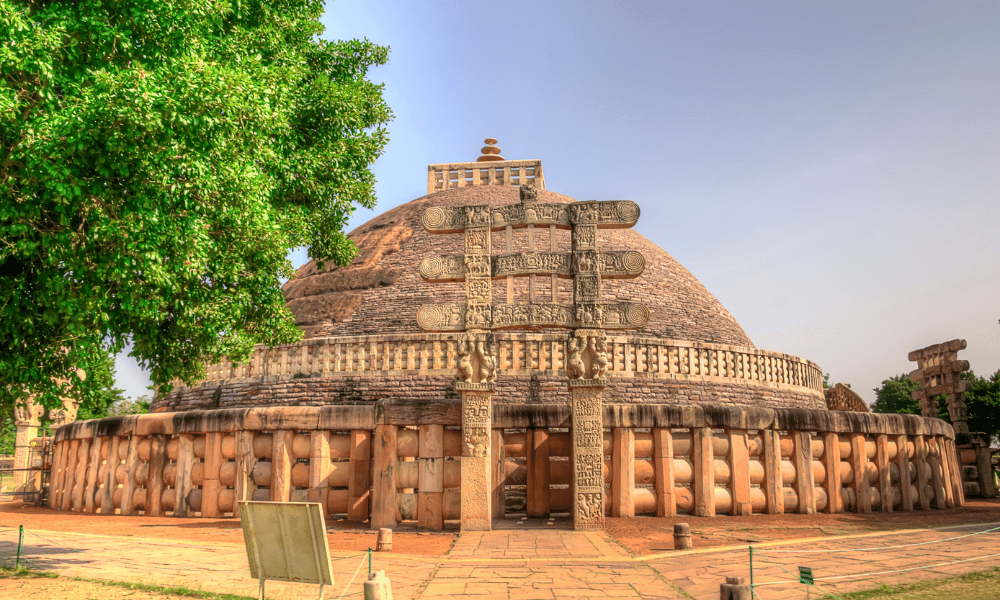
The Sanchi Stupa in Madhya Pradesh, India, is a beautiful example of Buddhist building from long ago in India. It is known as one of the earliest structures made of stone in the country. It was built in the 3rd century BCE. As with most ancient Indian stupas, the Sanchi Stupa is built in the style of pagoda with a hemispherical shape with a harmika, or square railing, at the top. In Buddhism, this building style stands for the way to enlightenment. The outside of the stupa is decorated with intricate stone figures that show stories from the Buddha's life and different Jataka tales. These add an artistic element to the architectural importance. India has a lot of spiritual and artistic history that can be seen in the Sanchi Stupa.
Mahabodhi Temple - India
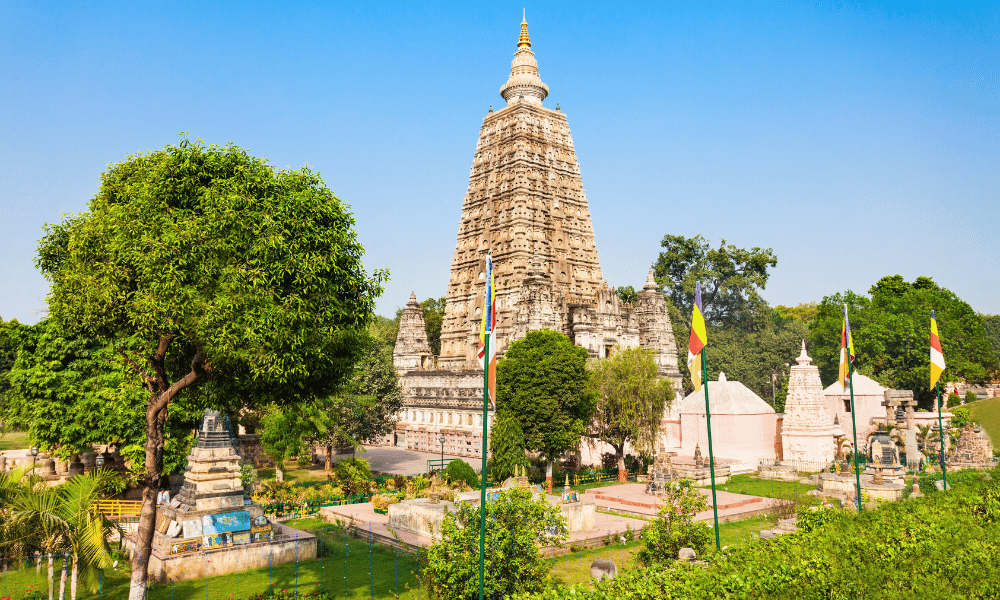
Located in Bodh Gaya, India, the Mahabodhi Temple is a very important site in the Buddhist faith. Lord Buddha, Siddhartha Gautama, is thought to have become enlightened under the Bodhi tree, which is marked by this holy site. The style of the temple's architecture comes from traditional Indian temples. The center tower, called the shikhara or vimana, rises gracefully into the sky and is a feature of these buildings. The building is a beautiful example of Indian temple architecture because it has beautiful designs and small details all over it.
The Mahabodhi Temple is a UNESCO World Heritage site, which shows how important it is in both religious and political terms. A lot of people from all over the world come to this holy place to honor the Bodhi tree and reflect. The temple complex is both a work of art and a place of worship. It is a live example of how important Buddhism is and how good Indian architecture was in the past. It's a spot where art, history, and faith all converge to offer everyone who visits a deep experience.
Tōdai-ji (Great Eastern Temple) - Japan
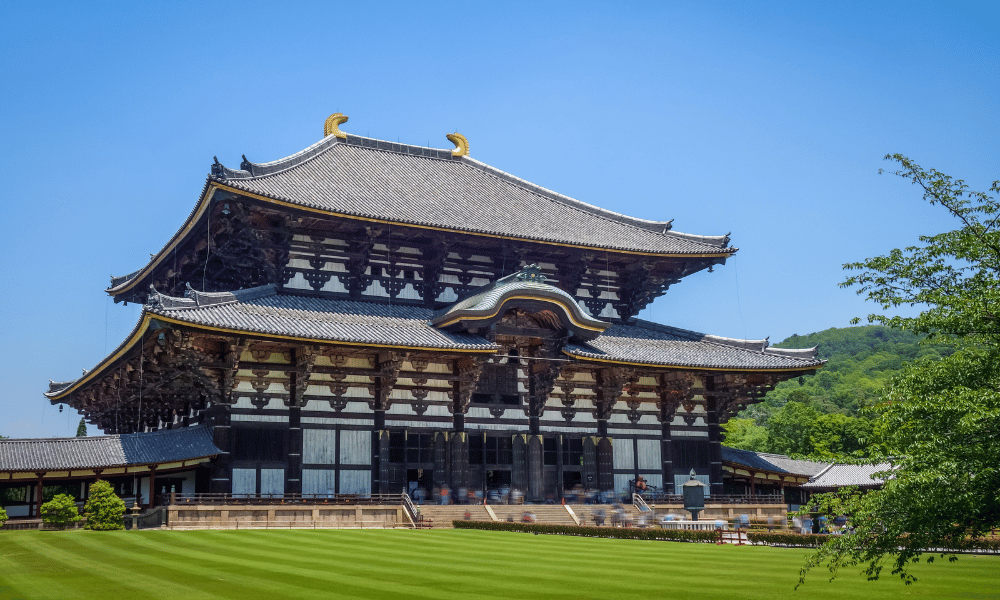
One of the most famous and historically important Buddhist shrines in Japan is Tōdai-ji, also known as the Great Eastern Temple. It is in Nara. This architectural style is a great example of how Japanese wooden pagodas are meant to look. Tōdai-ji is home to the huge Great Buddha Hall (Daibutsuden), a huge wooden building that holds the Great Buddha of Nara, the world's biggest bronze figure of the Buddha. This masterpiece of architecture is a perfect example of the traditional Japanese post-and-beam style. Its strong framework is made up of huge wooden posts and beams. The temple's architecture strikes a perfect balance between beauty and strength, making it a great example of Japanese devotion and skill. In addition to being a place of worship, Tōdai-ji is also a beautiful example of Japan's rich architectural heritage.
Five-story Pagoda at Horyu-ji - Japan
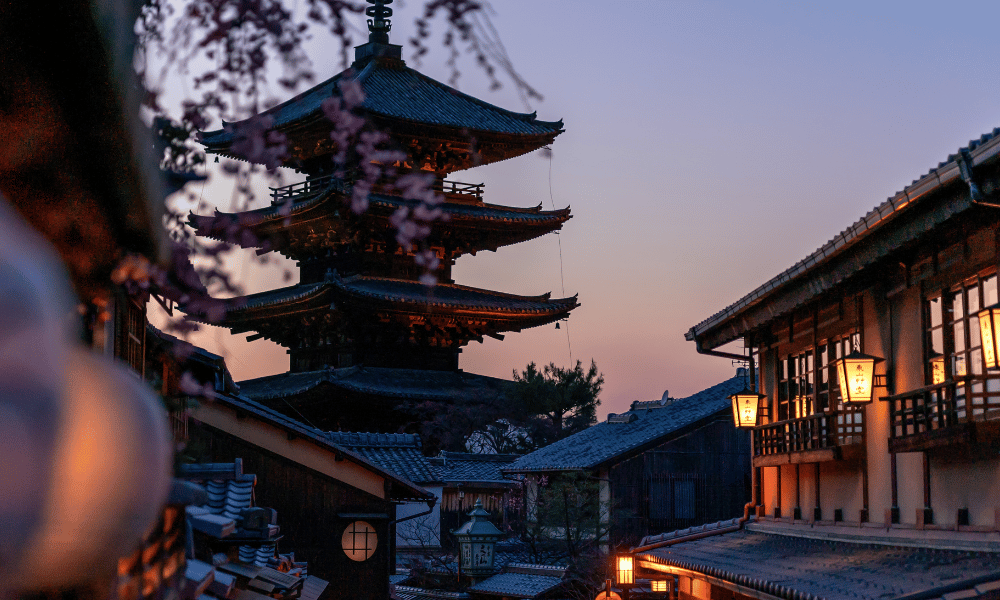
The Five-story Pagoda at Horyu-ji in Nara, Japan, is a beautiful example of a traditional Japanese wooden pagoda. The building is one of the oldest made of wood in the world; it was built in the seventh century. The style of the pagoda's architecture is a great example of the ease and simplicity that are typical of Japanese design. It has a structure with five levels, with each story getting smaller as it goes up and ending in a center spire. The pagoda's design, which uses wooden posts and beams to hold them together, shows how skilled and precise Japanese architects were in the past. The Horyu-ji Five-story Pagoda is not only a work of art in architecture, but also a lasting example of Japanese wooden pagodas, which are a symbol of both faith and traditional art.
Tianning Pagoda - China
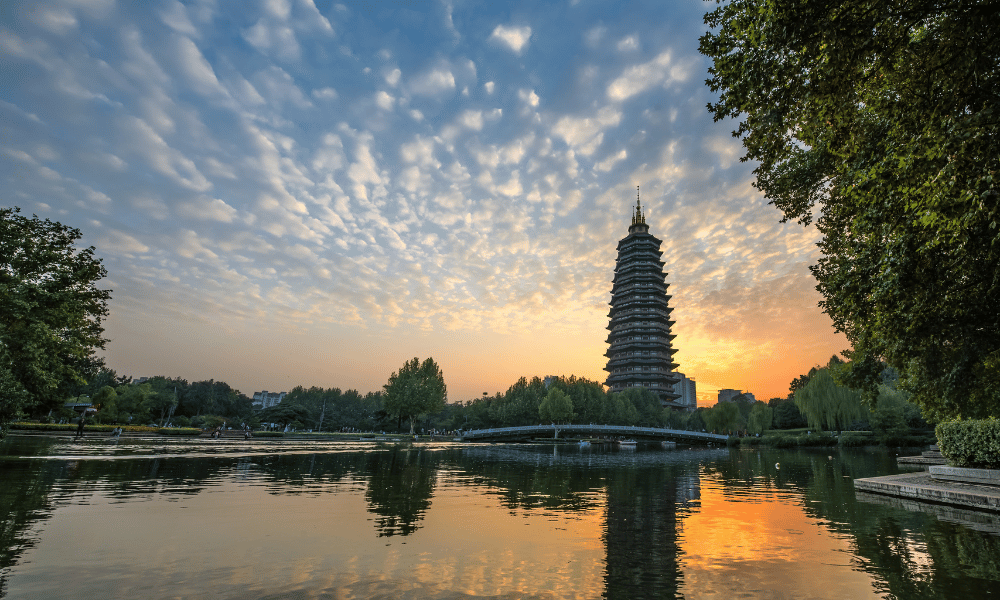
In Changzhou, China, the Tianning Pagoda is a beautiful example of Chinese pagoda building. This pagoda is 153.79 meters (505 feet) tall, making it the tallest in the world. This pagoda has a traditional Chinese design. It is built in an octagonal shape with multiple levels and beautiful raised eaves that make it look graceful and wide. The Tianning Pagoda is built in the way of Chinese pagodas, with lots of small bricks and careful craftsmanship. It is both a religious site and a cultural treasure, showing how deeply faith and beautiful architecture have been linked in Chinese history.
Giant Wild Goose Pagoda - China
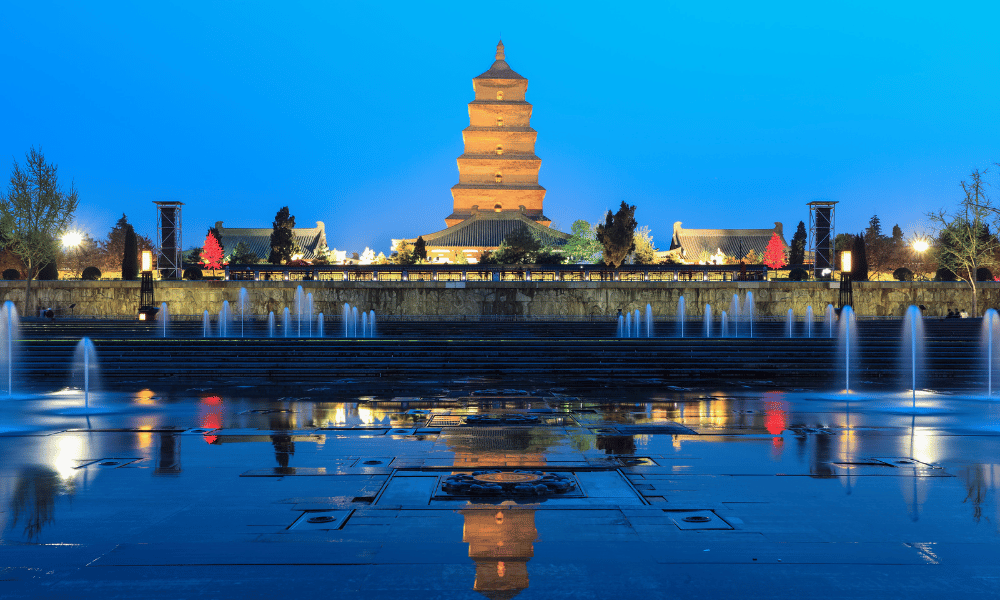
A famous example of ancient Chinese pagoda construction is the Giant Wild Goose Pagoda in Xi'an, China. This old pagoda was built to hold Buddhist texts that were taken from India. This building is a reminder of the spiritual and cultural importance of the Silk Road. It shows how East and West traded with each other. Built during the Tang Dynasty, it is known for having a beautiful, tiered structure with a square base. The style of the Giant Wild Goose Pagoda's architecture is typical of traditional Chinese style at the time. It is simple and elegant. It is a vivid example of the architectural and artistic achievements of the time, and it is still a beloved icon in China, drawing people in with its history and architecture.
Shwedagon Pagoda - Myanmar (Burma)
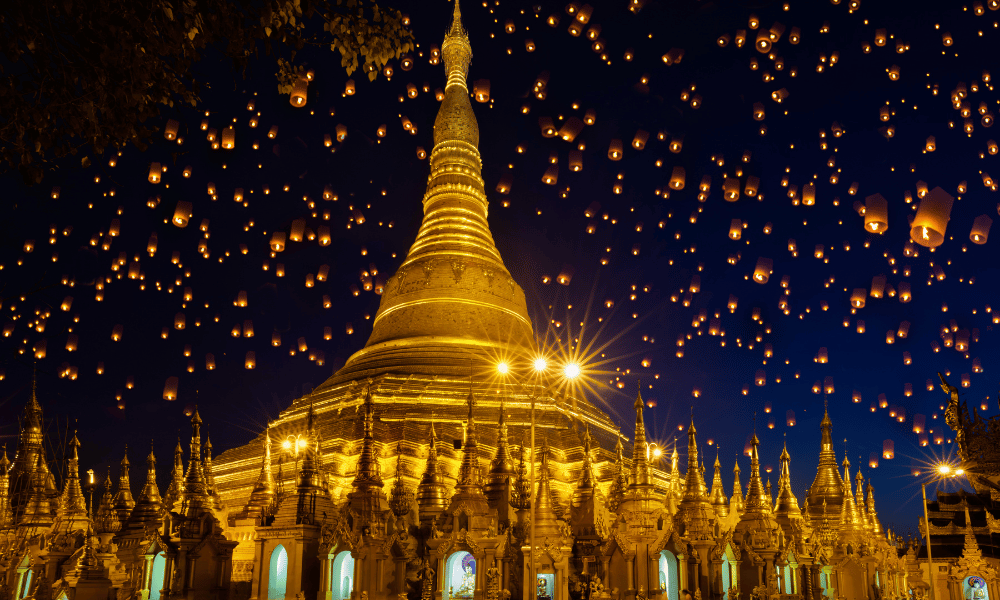
The Shwedagon Pagoda in Yangon, Myanmar (Burma), is an extraordinary testament to Burmese architectural and religious heritage. It is one of the most sacred and revered Buddhist pagodas in the world, known for its distinctive architectural style. The Shwedagon Pagoda's design is characterized by a towering, bell-shaped stupa adorned with thousands of gold leaf plates and a gilded diamond bud on its pinnacle. The pagoda's architectural style is rooted in Burmese tradition and craftsmanship, exemplifying the artistic skills and spiritual devotion of the region. It is a shimmering masterpiece that reflects the deep spiritual connection of the Burmese people to Buddhism and their rich architectural heritage.
Dabotap Pagoda - South Korea

The Dabotap Pagoda in Gyeongju, South Korea, is a beautiful example of how traditional Korean pagodas are built. This pagoda is part of the Bulguksa Temple complex. Its elegant and harmonious form is a great example of Korean craftsmanship. It's famous for the detailed carvings on the stone, like lotus flowers and Buddhist patterns that make it look more artistic. The Dabotap Pagoda is built in a unique style with a square base and many levels, each with intricate decorations. As an example of how Korean temple buildings combine spiritual devotion with good architectural skill, the pagoda is a cultural and artistic treasure in South Korea.
These pagoda temples represent the diverse architectural styles, cultural heritages, and religious traditions across East and Southeast Asia, as well as parts of South Asia. Each temple is not only a place of worship but also a testament to the rich history and artistry of the region in which it stands.
Conclusion
In conclusion, pagoda temples are more than just architectural landmarks; they are living proof of the intersection of culture, spirituality, and art across various Asian regions. The tiered designs, gracefully curved roofs, and intricate details woven into their structures serve as a gorgeous canvas for expressing the history and beliefs of these regions. Whether they take the form of East Asian pagodas or the vibrant shikharas and gopurams of Hindu temples, these towering structures symbolize the very core of faith, artistic brilliance, and aspiration.
The spiritual landscape is greatly influenced by pagoda temples. In Buddhism, these structures are referred to as stupas and contain sacred relics, symbolizing the path to enlightenment. Walking around these stupas is both a spiritual and a physical practice that helps people find inner peace and realize who they are. Each stupa represents the fundamental values of mindfulness, kindness, and the search of spiritual wisdom, making them not only places of worship but also places of self-discovery.
Pagoda temples are essential dwellings of various deities in Hinduism, serving as locations for worship, rituals, and cultural festivities. These temples' intricate carvings, vibrant festivals, and community gatherings demonstrate the unbreakable bond between spirituality and artistry. These temples symbolize a shared identity and serve as the setting for rituals and festivities that unite communities. As we delve into the world of pagoda temples, we discover not only architectural marvels, but also vibrant, living legacies that tell the stories of faith, devotion, and cultural continuity, inviting us to look into the profound value they hold for our experience as a whole.
Frequently Asked Questions (FAQs)
Here are some frequently asked questions (FAQs) about pagoda temples:
What is a pagoda temple?
A pagoda temple is a religious and architectural structure commonly found in various Asian cultures. Pagodas are characterized by their multi-tiered, often upward-curving roofs, and they serve as places of worship, meditation, and cultural significance.
What are the origins of pagoda temples?
The origin of pagoda temples can be traced back to ancient India, where they were initially called stupas in Buddhism. These structures evolved and spread to other parts of Asia, taking on various regional styles and names.
What is the purpose of pagoda temples?
The primary purpose of pagoda temples varies depending on the religion. In Buddhism, they are often used to house sacred relics and symbolize the path to enlightenment. In Hinduism, pagoda temples serve as places of worship for deities and are central to religious rituals and cultural celebrations.
What are the distinctive features of pagoda temples?
Key features of pagoda temples include multi-tiered roofs, intricate carvings, colorful decorations, and spiritual symbolism. The design can vary widely based on regional styles.
Where are pagoda temples commonly found?
Pagoda temples are primarily found in countries across Asia, including China, Japan, Korea, Myanmar, Thailand, India, Nepal, and more. Each region has its own unique variations of pagoda architecture.
Are all pagoda temples associated with Buddhism and Hinduism?
No, while pagoda temples are commonly associated with Buddhism and Hinduism, similar architectural styles and structures can be found in other religions and cultures. For example, Taoist temples in China may have pagoda-like structures.
What is the significance of the number of tiers in a pagoda?
The number of tiers in a pagoda can hold cultural and symbolic significance. In many cultures, odd numbers, such as three, five, or seven, are considered lucky or auspicious.
Do pagoda temples have specific religious rituals or practices associated with them?
Yes, pagoda temples often have specific rituals and practices associated with them, depending on the religion. These may include prayer, meditation, circumambulation (walking around the pagoda), and offerings.
Which is the tallest pagoda in the world?
Tianning Temple located in Changzhou City, Jiangsu Province, China is the tallest pagoda in the world with 13 stories and a height of 153.79 meters (505 ft).



